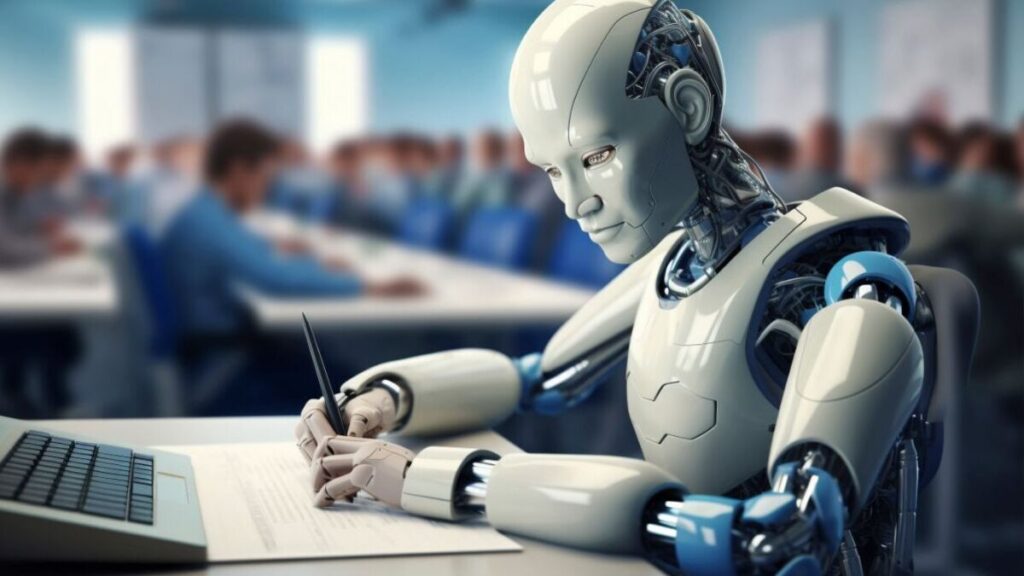Introduction
Education is evolving rapidly, thanks to artificial intelligence. For decades, visually impaired students have faced significant learning challenges due to a lack of accessible materials and specialized support. However, the Rise of AI Tutors is changing the landscape, making learning smarter and more inclusive for all.
- Introduction
- Understanding the Challenges Faced by Blind Students
- How AI is Transforming Education for the Visually Impaired
- Key Features of AI Tutors for Blind Students
- Benefits of the Rise of AI Tutors
- Case Studies: Real-Life Impact of AI Tutors on Blind Students
- Best AI Tutors Available for Blind Students Today
- How AI Tutors Work with Existing Assistive Technology
- Challenges in Implementing AI Tutors for the Blind
- Future of AI in Education for the Visually Impaired
- How to Advocate for More Accessible AI Tutors
- Conclusion
Imagine a world where blind students can receive instant, personalized tutoring through AI-powered voice assistants or braille-integrated technology. This is no longer a distant dream—it’s a reality shaping the future of education. AI-driven tutoring systems are breaking barriers, providing blind students with the tools to learn independently, master complex subjects, and achieve academic success.
This article explores how AI is revolutionizing education for blind students, the key features of AI tutors, their benefits, and what the future holds for inclusive learning.
Understanding the Challenges Faced by Blind Students
Blind and visually impaired students encounter numerous obstacles in traditional educational settings. Despite efforts to make learning more inclusive, several challenges persist:
Lack of Accessible Learning Materials
Most educational content is designed with sighted learners in mind. Textbooks, diagrams, and even digital content are often inaccessible, making it difficult for blind students to keep up with their peers. Braille books are available, but they are expensive and not always up to date with the latest curriculum.
Limited Availability of Specialized Educators
Teachers trained in educating blind students are rare. While schools offer special education programs, there is often a shortage of qualified instructors, leading to unequal learning opportunities. Many blind students rely on personal tutors or family members for additional support.
The Need for Independence in Learning
Blind students often struggle with self-paced learning due to their reliance on human assistance. Without accessible study tools, they face barriers to developing independent learning skills, which can impact their confidence and academic performance.
The Rise of AI Tutors aims to bridge these gaps by offering accessible, interactive, and personalized education solutions for blind students.
How AI is Transforming Education for the Visually Impaired
Artificial Intelligence is not just enhancing learning for sighted students; it is a game-changer for the visually impaired as well. AI-powered tutors provide:
Personalized Learning Experiences
AI adapts to individual learning styles, helping blind students progress at their own pace. Whether through audio-based lessons, interactive Q&A sessions, or real-time feedback, AI makes learning more engaging and efficient.
Real-Time Feedback and Support
One of the biggest advantages of AI tutors is instant feedback. Unlike traditional learning, where blind students have to wait for teacher reviews, AI provides immediate corrections and guidance, helping students grasp concepts faster.
AI-Powered Text-to-Speech and Braille Conversion
Many tutors integrate advanced text-to-speech technology, making written content accessible through voice. Some even convert digital text into braille, ensuring that blind students can read and interact with educational materials independently.
The Rise of AI Tutors is transforming how blind students access information, making learning smarter, faster, and more inclusive.
Key Features of AI Tutors for Blind Students
Artificial intelligence tutors are designed to accommodate the unique needs of visually impaired learners. Some of the standout features include:
Voice Interaction and Speech Recognition
AI tutors like Google Assistant and Alexa have revolutionized accessibility by enabling voice-activated learning. Blind students can ask questions, receive explanations, and even complete exercises through voice commands.
Braille Integration with AI Technology
Innovations like AI-powered braille displays and keyboards allow blind students to read and write seamlessly. Some AI tutors convert spoken words into braille text, creating a fully interactive learning experience.
Adaptive Learning Techniques
AI tutors analyze student progress and adjust lessons accordingly. If a student struggles with a particular concept, the AI modifies the teaching approach, providing additional explanations or alternative methods.
These features ensure that AI tutors cater to the specific needs of blind students, making learning more effective and enjoyable.
Benefits of the Rise of AI Tutors
The introduction of AI tutors has brought a wave of positive change for blind students, offering numerous benefits:
Increased Independence and Confidence
Blind students no longer have to rely solely on human assistance. With AI tutors, they can study independently, boosting their confidence and self-reliance.
Customized Learning Paths
Every student learns differently, and AI tutors adjust lessons based on individual progress. This personalized approach ensures that blind students receive the best possible education tailored to their needs.
Breaking Barriers in STEM Education
STEM (Science, Technology, Engineering, and Mathematics) subjects have traditionally been difficult for blind students due to their visual nature. AI tutors use tactile graphics, sound-based coding programs, and interactive explanations to make these subjects more accessible.
The Rise of AI Tutors is proving to be a powerful tool in making education fairer and more inclusive for visually impaired learners.
Case Studies: Real-Life Impact of AI Tutors on Blind Students
To understand the true potential of AI tutors, let’s explore real-life stories of visually impaired students who have benefited from this technology.
A Young Student Excelling in Mathematics
Sarah, a 12-year-old blind student, used to struggle with math. Traditional teaching methods often relied on visual explanations, making it hard for her to grasp concepts. However, after her school introduced an AI-powered tutor that used voice guidance and braille-based math tools, her learning experience changed completely. The AI tutor provided her with step-by-step explanations, personalized practice questions, and real-time feedback, allowing her to improve significantly. Today, Sarah is among the top students in her class.
A University Student Learning Computer Programming
Michael, a visually impaired college student, had a passion for coding but found it challenging to learn through standard textbooks. AI-driven programming tools helped bridge this gap. By using voice-assisted coding platforms and AI-powered braille displays, Michael was able to write, test, and debug code independently. His AI tutor even provided spoken explanations of error messages, making troubleshooting easier. Now, he is working on developing his accessibility-focused mobile application.
Educational Institutions Adopting AI Tutors
Several schools and universities worldwide have started integrating AI tutors to make learning more inclusive. Institutions like Stanford and MIT are working on AI-driven accessibility tools to assist blind students in STEM fields. These efforts prove that the Rise of AI Tutors is not just a theoretical concept but a practical solution making a real difference.
Best AI Tutors Available for Blind Students Today
AI tutors designed for visually impaired students come with specialized features that enhance accessibility. Let’s look at some of the best AI tutors currently available.
Microsoft Seeing AI
- Uses AI-powered speech recognition to describe surroundings, read text, and assist with daily learning activities.
- Helps blind students read books, solve equations, and understand digital content.
Be My Eyes
- An AI-powered app that connects blind users with sighted volunteers for real-time assistance.
- Useful for interpreting visual elements like graphs, images, and complex diagrams.
Orcam Read
- A smart AI-powered reading device that converts text to speech.
- Helps visually impaired students read printed materials like textbooks, newspapers, and notes.
Google Lookout
- Uses AI to scan documents and read them aloud to blind users.
- Great for accessing digital and physical study materials independently.
Each of these tools plays a crucial role in the Rise of AI Tutors, helping blind students overcome learning barriers and gain educational independence.
How AI Tutors Work with Existing Assistive Technology
AI tutors do not function in isolation—they work seamlessly with existing assistive technologies to enhance learning experiences for visually impaired students.
Integration with Screen Readers
AI tutors are designed to work with popular screen readers like:
- JAWS (Job Access With Speech)
- NVDA (NonVisual Desktop Access)
- VoiceOver (Apple’s built-in screen reader)
These screen readers allow AI tutors to provide text-to-speech feedback, enabling blind students to navigate learning platforms efficiently.
Compatibility with Braille Displays
Some AI tutors integrate with refreshable braille displays, which allow blind students to “read” digital content through braille cells that dynamically update. This feature helps students access educational materials in a format that suits them best.
Working with Smart Voice Assistants
AI tutors often work alongside voice assistants like:
- Amazon Alexa
- Google Assistant
- Apple Siri
This integration enables students to ask AI tutors complex questions, receive step-by-step guidance, and even complete interactive exercises—all through voice commands.
By working in harmony with these technologies, AI tutors enhance accessibility and create a more seamless learning experience for blind students.
Challenges in Implementing AI Tutors for the Blind
Despite their numerous advantages, AI tutors also come with challenges that need to be addressed to ensure their effectiveness for visually impaired students.
High Development Costs
Developing AI-powered educational tools that cater specifically to blind students requires significant investment. Many institutions lack the funding needed to implement such technologies at scale.
Ensuring Inclusivity in AI Training Models
AI tutors must be trained on diverse datasets to ensure they understand various accents, languages, and accessibility needs. Bias in AI training models can result in inaccurate or ineffective assistance for blind students.
The Need for User-Friendly AI Interfaces
Many existing AI tutors require a learning curve, making them difficult for some students to use effectively. Creating intuitive, voice-controlled, and easily navigable interfaces is essential for broader adoption.
Addressing these challenges is crucial for maximizing the potential of the Rise of AI Tutors and making education truly inclusive.
Future of AI in Education for the Visually Impaired
The future of AI-driven education is promising, with ongoing advancements that aim to make learning more accessible for blind students.
Predicted Advancements in AI Learning
- Improved AI-powered braille devices with enhanced accuracy and affordability.
- More interactive voice tutors that engage students in deep learning discussions.
- AI-driven smart classrooms where blind students can participate in real-time discussions and interactive lessons.
The Role of AI in Inclusive Education Policies
Governments and educational institutions are beginning to recognize the importance of AI in accessibility. Future policies may require schools to integrate AI tutors into their curriculum, ensuring that blind students have equal learning opportunities.
As AI technology evolves, we can expect even more groundbreaking innovations that will further support visually impaired learners.
How to Advocate for More Accessible AI Tutors
Ensuring that AI tutors become a standard educational tool for blind students requires advocacy and action from multiple stakeholders.
Role of Policymakers and Educators
- Government funding should be allocated to AI-driven accessibility programs.
- Educational institutions must incorporate AI tutors into their curriculum.
- Teacher training programs should include AI literacy to help educators assist blind students effectively.
How Individuals Can Support AI Accessibility
- Raise awareness about the importance of AI tutors in accessible education.
- Support nonprofit organizations that develop AI tools for visually impaired students.
- Encourage tech companies to prioritize accessibility in AI development.
By working together, we can ensure that the Rise of AI Tutors benefits all learners, regardless of their visual abilities.
Conclusion
The Rise of AI Tutors is revolutionizing education for blind students, making learning smarter, more inclusive, and more accessible. From personalized tutoring and real-time feedback to AI-integrated braille systems, these technological advancements are empowering visually impaired students to learn independently and excel academically.
While challenges such as high costs and inclusivity in AI models remain, the future holds immense potential for further innovation. By advocating for more accessible AI tutors, we can create a world where education is truly inclusive for everyone.


